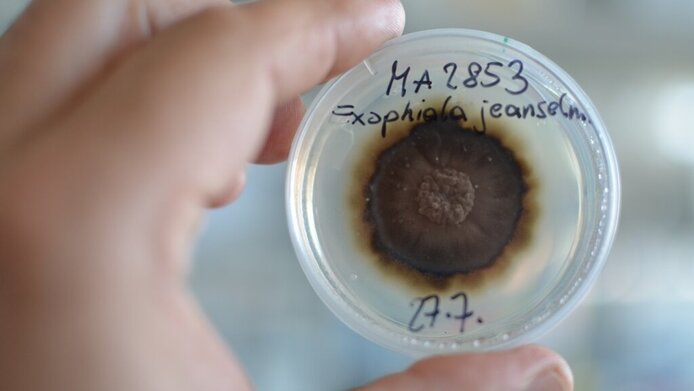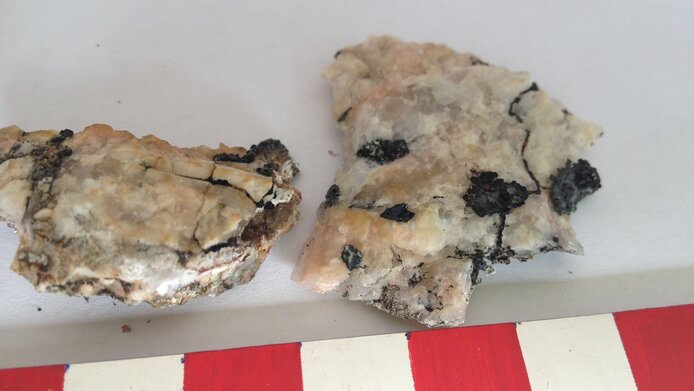Small and extremely resilient: the secrets of black fungi

They are true survival artists, not minding the cold any more than they do heat. Whether their environment offers little or plentiful oxygen, is wet, salty, dry or has contaminated soils – the black fungi keep their cool and feel at home in even the most inhospitable of living conditions. How do they do that? “To our great surprise, the fungi show almost no stress response at all. This means something in their structure makes them inherently resistant to stress”, relates Katja Sterflinger. With the support of the Austrian Science Fund FWF, the microbiologist used a climate chamber to simulate different stress situations as the fungi encounter them in climatically extreme regions such as the Arctic or deserts. She first observed how the cells of the fungi, or, more precisely, its proteins, react to cold, heat, ozone or aridity.
Unique “protein tool”
Katja Sterflinger heads the Extremophile Center at the Vienna Institute of Biotechnology (VIBT), University of Natural Resources and Life Science. The climate chambers, built specifically for the Institute, and the use of cutting-edge sequencing technologies have made it possible for the first time to identify the proteins of black fungi. “This was very difficult, because they are not like or even comparable to anything else we have seen so far”, notes Sterflinger. The researchers have now learned that the “microcolonial fungi”, as the technical term goes, have a unique protein system that enables them to grow both at 0°C or at 45°C. The microbes even survived a simulated trip to Mars. All it takes them to achieve that is some minor molecular adjustment. “Depending on whether it is hot or cold, the fungi will change a little. But that is just fine-tuning”, notes Katja Sterflinger. This is actually a very smart move on the part of the fungi, because any dramatic changes would consume energy. The fungi have no need for that and therefore remain active even in low-nutrient environments such as glaciers or stone.
Understanding cellular processes
In a next step, the team headed by Sterflinger matched the protein data yield with the transcriptome data, i.e. they analysed the sequence of cellular processes. The researchers discovered that the cellular secret seems to be less related to the proteins than to the non-coding RNA (ribonucleic acid). These molecules are active in the cell without being translated into proteins. While their biological functions had been largely undetermined until recently, it is now known that they have an important role in regulating a variety of cellular processes. After all, only two percent of the genetic material that is actively read is translated into proteins.
The exceptional talent of Exophiala dermatitidis
Among the hundreds of fungal strains the Viennese researchers have investigated to date, Exophiala dermatitidis has turned out to be a particularly versatile extremophile. This microfungus, also known as ‘black yeast’, is found across all temperature ranges from cold to warm and withstands simply everything. “It grows on glaciers just as in saunas, and, unfortunately, also in our dishwashers. And it has the disagreeable property of being a human pathogen”, explains Katja Sterflinger. This is the negative side of the fungus. On the plus side, it has an optimal talent for degrading hydrocarbons, i.e. toxins. This latter quality induced the microbiologists from the Extremophile Center to launch a second FWF-funded project in which they screened more than 200 black yeasts in their search for a biological “cleaner” for exhaust fumes and contaminated soils. Apart from Exophiala they found only one more fungus with the ability to degrade environmental toxins. – Unfortunately, this second variety is also closely related to human pathogen strains, which meant that plans for using them as biofilters have been shelved for the time being.
Medical focus
Instead, the experts from Vienna’s University of Natural Resources and Life Science now focus on medical issues and have set out to investigate the molecules of the pathogenic Exophiala dermatitidis more closely, since the fungus not only provokes infections in people with weak immune systems, but also increasingly in individuals of average good health, as Sterflinger notes, underlining the relevance of her research for medical science. According to the microbiologist, the extreme stress tolerance of the fungus is probably related to its pathogenicity. “This is an area we still don’t know enough about. It is our goal to find out more about the virulence factors of the fungus.”
Personal details Katja Sterflinger is the head of the Extremophile Center at the Vienna Institute of Biotechnology (VIBT), University of Natural Resources and Life Science. The microbiologist specialises in the study of fungi and black yeasts and as such is a sought-after expert when it comes, for instance, to the preservation of monuments.
Publications and articles






